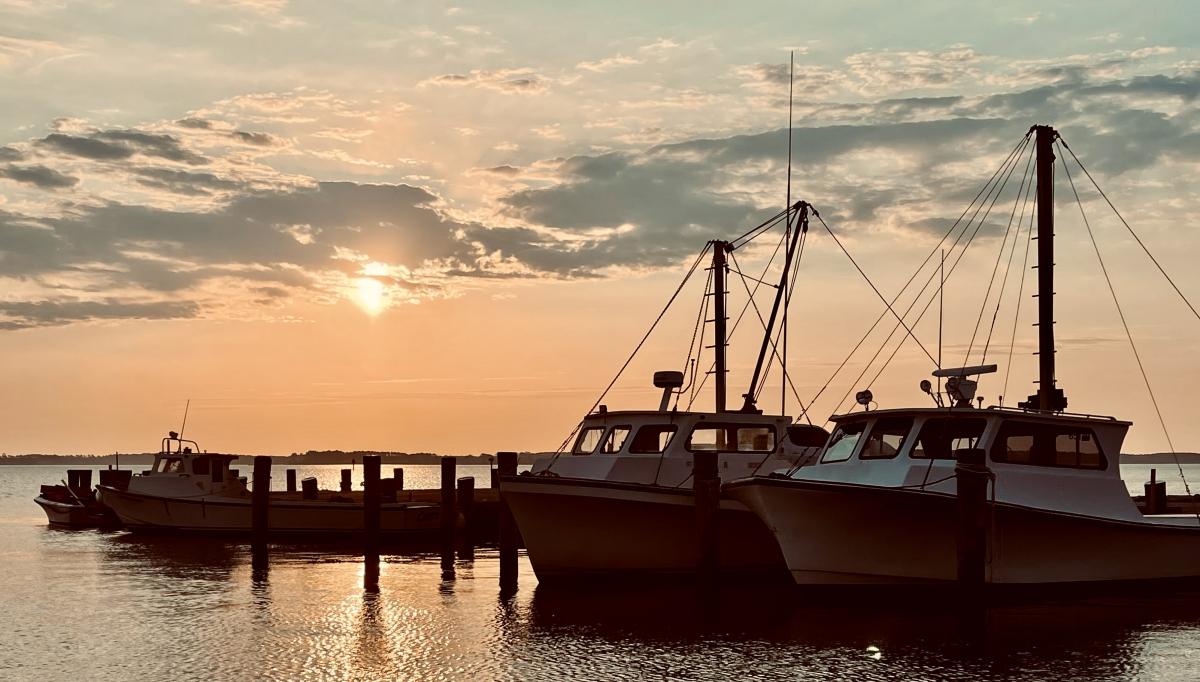
Oystering vessels at the public dock in Neavitt near the mouth of Broad Creek. Photo by Dennis Forney
The estimated harvest of 620,000 bushels of oysters from natural bars in the Maryland portion of Chesapeake Bay during the 2022-2023 season is the highest since the 976,000 bushel harvest recorded in the 1986-’87 season.
Information provided by the Shellfish Division of the state’s Department of Natural Resources indicates that while the oyster population is trending in a positive direction, it’s still a long way from the boom years of more than a century ago when annual harvests counted in the several millions of bushels.
The dockside value of this year’s harvest, based on an average bushel price of $30 over the course of the October through March season, comes in at $18,600,000. That’s a $2,310,00 increase – 14 percent – over the value of the 543,000 bushels harvested during the 2021-’22 season. Excellent working conditions weatherwise and strong sets of baby oysters over the last few years led to daily-limit harvests for the tongers, dredgers and divers who work the Chesapeake and its tributaries.
Dockside chatter indicates that the East Coast market remained relatively strong through the season. So strong in fact that Virginia extended its season by a month leading to some watermen in Maryland’s portion of the Bay seeking a similar extension here. However, according to Maryland Shellfish Division Director Chris Judy, that wasn’t given serious consideration among Maryland’s resource managers.
“Maryland did not consider extending the oyster season, as did Virginia. We have kept the same harvest rules, such as the daily bushel limit and season length and others, as a conservative approach to managing the population and fishery,” said Judy.
In response to questions about the steady improvement in harvests over the past few years, Judy reiterated that strong spat sets, low prevalence of disease, low mortality rate and a healthy balance between fresh and salty water are the primary reasons for the upward trends. But he was careful to sound a cautionary note as well: “Spat sets have been good recently, the biomass index – size and numbers of oysters – is trending upwards, and certain areas show an abundance of oysters. However, other areas are not getting good spat sets or showing large numbers of oysters, due to low salinity which impacts the population. Again, even though there are positive trends with oysters they are not yet recovered or restored.”
Recent surveys have found virtually no sets of little oysters in the upper part of Maryland’s portion of the Chesapeake. Low salinity in that section of the Bay has long been a perennial problem.
The healthiest spat sets and harvests in recent years have come in the waters in and around Tangier Sound. One area of hope has come in the waters of Eastern Bay and the Miles and Wye Rivers where declining spat set trends have started to turn around.
Another reason why harvests have increased over the past few years is more watermen targeting oysters, which is natural considering stronger markets and growing oyster populations. For example, for the 2021-’22 wild oyster season, 1,228 individuals paid the oyster surcharge for their commercial licenses. For the 2022-’23 season, that number increased to 1,316 surcharges.
During October and November each fall, state scientists take to the Bay’s waters to dredge approximately 345 samples from 271 bars throughout Maryland’s portion of the Chesapeake to monitor the health of the oyster population. The results of that survey are compiled in an annual report.
Here are some statements made in the conclusion of the most recent full report, compiled in 2021:
“ . . . the positive trends in population indicators that began 12 years ago and have substantially improved over the past three years offer encouragement that a corner has been turned. Three years is a relatively short period of time for predicting trends, and it remains to be seen whether the oyster population continues to grow. Nevertheless, the past dozen years has seen a net gain for oysters in Maryland, especially when compared with the devastated post-epizootics [disease-ridden] populations of the previous decade. … Whether these trends will continue remains to be seen. But barring the resurgence of disease or some yet unknown threat, there is every reason to believe that oysters can continue to flourish in Maryland. They are a resilient species.”
Dennis Forney has been a publisher, journalist and columnist on the Delmarva Peninsula since 1972. He writes from his home on Grace Creek in Bozman.
Data




Edwin c Smith 111 says
Another reason for a healthy oyster population is the use of dredges for harvesting. A dredge cleans the shells on the harvesting area much better than other methods and scatters the small oysters that are returned to the bottom which causes them to have a better food source and that makes them more adapt to fighting diseases.